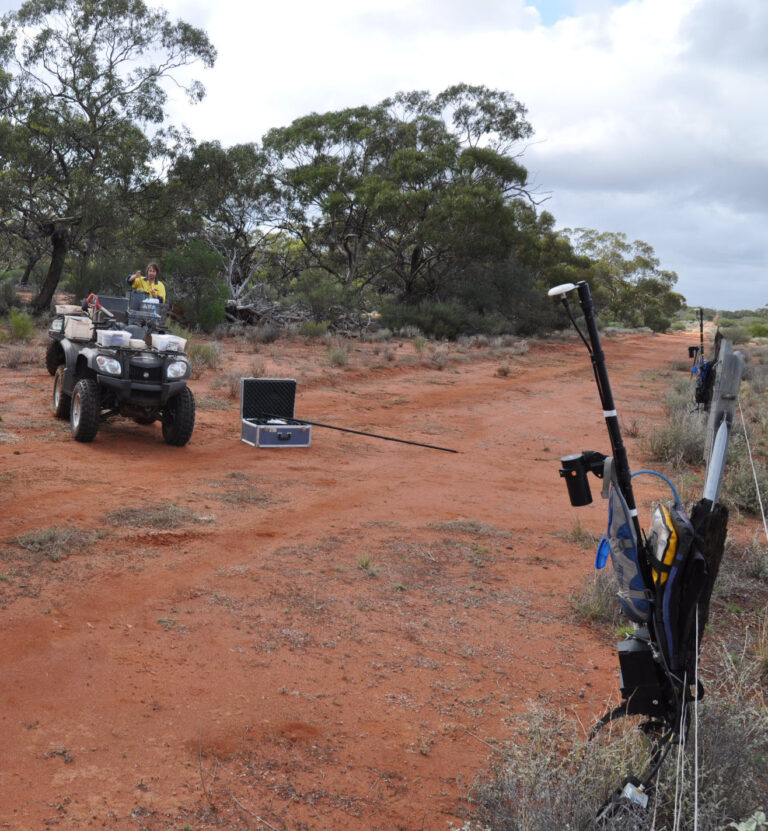The GEM Systems GSMP-35 potassium magnetometer is an optically pumped potassium vapor magnetometer. The GSMP-35 is also known as the “k-mag” just as Cesium magnetometers are know as “Cs-mags”. As of August 2013, GEM Advanced Magnetometers is the ONLY company offering these magnetometers to the market.
The GSMP-35 is the most sensitive magnetometer commercially available. By commercially available, I mean you can buy it today, and have it operating tomorrow. K-mags are ideal for magnetic gradiometer applications due to their extreme sensitivity. These sensors are so sensitive, we are finding our customers can even detect non-magnetic items as disturbances in the surrounding rock types or soil. This was the case at the Ellendale Diamond Mine in Australia where extensions to known lamproites were found. Some phases of the lamproites are non-magnetic and yet the k-mag detected the textural changes in the host sedimentary rocks that gave away the presence of these potentially diamondiferous phases. Due to the extreme sensitivity and absolute accuracy of these magnetometers they are also ideal for coal, geotechnical and mineral sand applications. Mineral sands deposits range from 25nT to essentially non-magnetic on the ground depending upon the illmenite content. A typical deposit is only 1-3 nT in amplitude. If a Cesium sensor is used for these deposits, the 1.5nT striping from the heading error can severely degrade the quality of the data and mask the signal from the deposit. At the very least, tie lines will be required to try to remove the stripes in the Cesium magnetometer data. However tie lines reduce productivity by 10% or so, and then you need the software to be able to tie line level the data which is expensive.
In contrast, the k-mag has a negligible heading error, which is to do with the physics of the sensor, not ferrous material on the backpack. The gradient tolerance and dynamic range of the GSMP-35 is leading the industry. Out of the box the gradient tolerance is >35,000 nT per meter and the dynamic range is 20,000-120,000 nT. As an option, the upper range can be set to 250,000 nT at the (slight) expense of the lower range and some sensitivity. These specifications make potassium magnetometers ideal for Iron Ore exploration. In fact, GEM calls this option the “Iron Mag”.
I was first exposed to potassium magnetometers in 2004 when I was working for De Beers in Russia. We knew that the nearby Lomonosov kimberlites where essentially non-magnetic, so we needed the best magnetometer on the contract. Enter the Saint Petersburg Geophysical Company. They had access to an ex-military potassium magnetometer. They had a towed bird system installed in a low and slow flying Antonov AN-2 bi plane! The data was so good and clean, we were detecting sheets of corrugated iron during our ground truthing. I have not used another magnetometer since.
GEM Systems commercialized the potassium magnetometer around 2006. Admittedly at the start there were some technical issues, as there always are. Seven years later potassium magnetometers are at the leading edge, rather than the bleeding edge of magnetometry.
Nowadays Modern Mag ONLY operates potassium magnetometers in the field. The magnetometers that most contractors use in Australia, the Overhauser, we use as base station magnetometers!
I think if more geophysicists were exposed to the data from the potassium magnetometer, sales of Cesium magnetometers, particularly for ground applications, would plummet. Especially when you consider that the GSMP-35 is cheaper than some Cs-mags.
The k-mag also comes with a built in navigation (important!) and Li-ion batteries. It has a 2 year warranty. Gradiometer, VLF and IronMag are options on the ground system and lighter casing is available as an option for the airborne system.
So is the k-mag for you? If you can afford a Cs-mag you should buy the k-mag instead. Remember, do not buy ANY magnetometer without built in navigation as this will either double survey costs or halve production. If you are surveying in rugged terrain and thick vegetation, you should buy the GSMP-35 with the lightweight Modern Mag backpack. This backpack has several advantages over the standard backpack. The most important advantage is that all tree hook antennas have been removed and all extensions are below head height.



